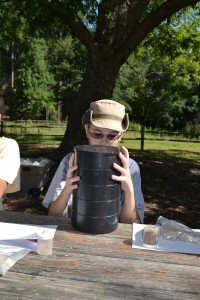“Bah,” you are thinking. “Do I really need to integrate science and MATH into our education offerings? This is not what I signed up for….” The simple answer to that question is you should probably try, and I think you will have fun. Before you get defensive, I am a historian with dubious math skills and a checkered history when it comes to science. Still, I am encouraging all of my fellow historic house lovers to get on the STEM train, edutain some kiddos, and help out a teacher or two.
 “Fine,” you say. “What is STEM anyway?” The acronym STEM stands for science, technology, engineering, and math. Despite our wishes, no academic discipline functions in a vacuum. STEM lesson plans bring these topics together as they actually interact in the real world. They expose students to these disciplines with an eye towards application and problem solving, ideally preparing them for a future job market that will require these skills in spades. (I would be remiss if I did not mention that politicians and economists are also hoping a STEM focus will help boost the United States’ presence in the tech industry.)
“Fine,” you say. “What is STEM anyway?” The acronym STEM stands for science, technology, engineering, and math. Despite our wishes, no academic discipline functions in a vacuum. STEM lesson plans bring these topics together as they actually interact in the real world. They expose students to these disciplines with an eye towards application and problem solving, ideally preparing them for a future job market that will require these skills in spades. (I would be remiss if I did not mention that politicians and economists are also hoping a STEM focus will help boost the United States’ presence in the tech industry.)
“Why, as a curator or historian, should I care about STEM?” STEM offers us an opportunity to serve our community and to remain relevant. State and national academic standards are being released and rewritten every day, but they almost all have STEM in common. Teachers are being asked to teach these subjects and help students apply the principles learned across disciplines. We can help them do that! If the students happen to have loads of fun and learn about history at the same time, our job is done for the day. 
Now, for those who are math impaired or are thankful for technology, but have no idea what is actually happening, you really can do this! It may take a little bit of research and a little bit of ingenuity, but I believe in you.
“How do I make this work within our mission statement?” Remember that “nothing exists in a vacuum” comment? First, think about the technology of the past and the people that inhabited your house. Does your house have an old grandfather clock? Maybe it is time to learn about gears and pendulums. Did it have electric lights originally powered by a generator? Go to the library and figure out how those old generators worked. Is the house architecturally interesting? Go to the building science section and learn about force and load bearing…things.
 Were any of the people who lived in the house doctors, scientists, builders, innovators, entrepreneurs, or mathematicians? Did they travel via steam ship? Did they mention train travel in any of their letters? Did they have an old telephone? (How do land lines work anyway?) So what if they were farmers? Farming is all about solving problems. Did they use a pump or a pulley system to bring up water from the well? Did they own a tractor? Are there any apps or other modern day technologies that might have made their lives or jobs easier? These are the type of questions that can help you get started on the road to making STEM a part of your interpretation.
Were any of the people who lived in the house doctors, scientists, builders, innovators, entrepreneurs, or mathematicians? Did they travel via steam ship? Did they mention train travel in any of their letters? Did they have an old telephone? (How do land lines work anyway?) So what if they were farmers? Farming is all about solving problems. Did they use a pump or a pulley system to bring up water from the well? Did they own a tractor? Are there any apps or other modern day technologies that might have made their lives or jobs easier? These are the type of questions that can help you get started on the road to making STEM a part of your interpretation.
STEM has always been around, lurking in the corners of our Victorian mansions, Eastlake parlors, Craftsman bungalows, and rustic cabins. It is time to drag it out and play. Explain the basics of these technologies and scientific achievements to your students and then give them a problem to struggle with and solve! Let them play with gears and pulleys, building blocks and erosion tables, telephones and Morse code. They will be smiling. Your teachers will be smiling, and I am sure you will smile too.



